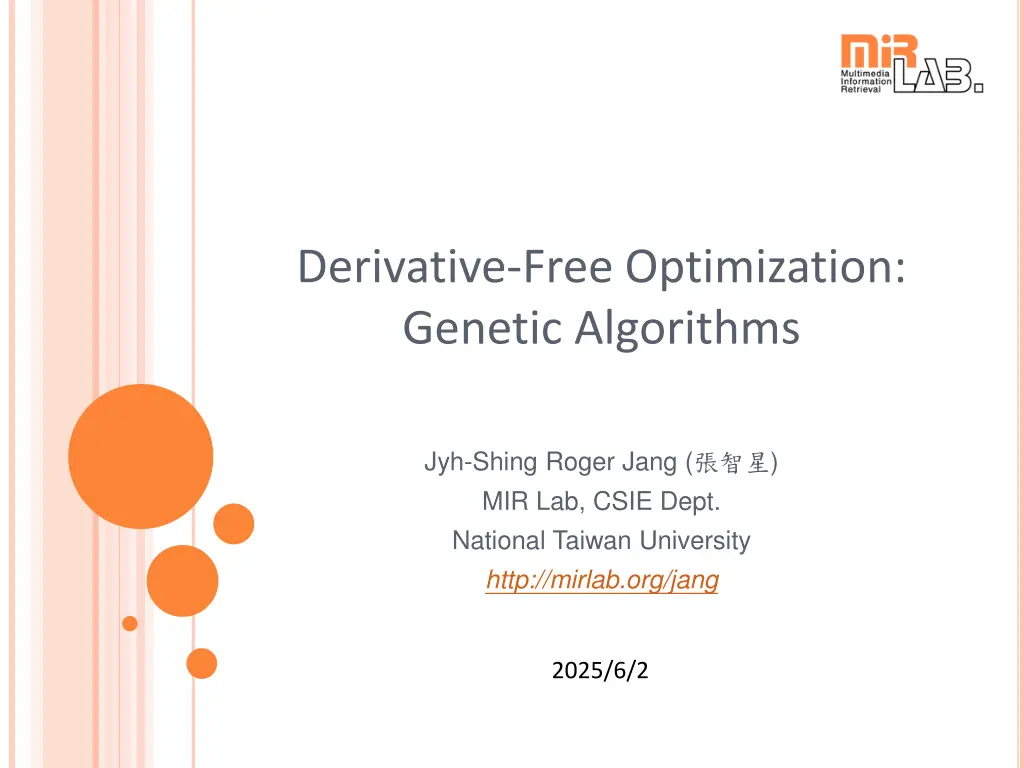
Understanding Genetic Algorithms for Derivative-Free Optimization
Learn the fundamental concepts and applications of genetic algorithms (GA) for derivative-free optimization. Explore motivation, terminology, encoding, crossover, mutation, reproduction, and an example problem to find the maxima of the peaks function. Discover how GA emulates the evolutionary process and revolutionizes optimization methods.
Download Presentation

Please find below an Image/Link to download the presentation.
The content on the website is provided AS IS for your information and personal use only. It may not be sold, licensed, or shared on other websites without obtaining consent from the author. If you encounter any issues during the download, it is possible that the publisher has removed the file from their server.
You are allowed to download the files provided on this website for personal or commercial use, subject to the condition that they are used lawfully. All files are the property of their respective owners.
The content on the website is provided AS IS for your information and personal use only. It may not be sold, licensed, or shared on other websites without obtaining consent from the author.
E N D
Presentation Transcript
Derivative-Free Optimization: Genetic Algorithms Jyh-Shing Roger Jang ( ) MIR Lab, CSIE Dept. National Taiwan University http://mirlab.org/jang 2025/6/2
Outline Introduction Basic concept of genetic algorithms (GA) Examples Summary 2/11
Motivation behind Genetic Algorithms Look at what revolution brings us? + Learning & reasoning Can we emulate the evolutionary process with today s fast computers? 3/11
Terminology in Genetic Algorithms Fitness function Objective function to be maximized Population Samples within the parameter space Encoding scheme How to encode a sample in the parameter space into a binary string Selection How to select the best individuals Crossover & mutation How to generate the next population for exploration Elitism Always keep the best several samples for the next generation 4/11
Encoding, Crossover, and Mutation Binary encoding Chromosome (11, 6, 9) 1011 0110 1001 Gene Crossover Gene 1 0 0 1 1 1 1 0 0 1 1 1 1 1 1 0 0 1 1 1 0 0 1 0 1 0 0 1 0 0 1 0 Crossover point Mutation 1 0 0 1 1 1 1 0 1 0 0 1 1 0 1 0 Mutation bit 5/11
Reproduction From one generation to the next one 10010110 01100010 10100100 10011001 01100101 . . . . . . . . . . . . 10010110 01100010 10100100 01111001 10000101 . . . . . . . . . . . . Elitism Mutation Selection Crossover Current generation Next Sorted in descending order of fitness value generation 6/11
Example Find the max. of the peaks function z = f(x, y) = 3*(1-x)^2*exp(-(x^2) - (y+1)^2) - 10*(x/5 - x^3 - y^5)*exp(-x^2-y^2) -1/3*exp(-(x+1)^2 - y^2). = 1 x ( ) ( ) ( ) ( ) 2 2 2 2 2 2 2 + + 1 3 5 1 x y x y x y , 3 1 10 f x y x e x y e e 5 3 7/11
Optimization based on Derivatives Derivatives of the peaks function dz/dx = -6*(1-x)*exp(-x^2-(y+1)^2) - 6*(1-x)^2*x*exp(-x^2-(y+1)^2) - 10*(1/5-3*x^2)*exp(-x^2-y^2) + 20*(1/5*x-x^3-y^5)*x*exp(-x^2- y^2) - 1/3*(-2*x-2)*exp(-(x+1)^2-y^2) dz/dy = 3*(1-x)^2*(-2*y-2)*exp(-x^2-(y+1)^2) + 50*y^4*exp(-x^2- y^2) + 20*(1/5*x-x^3-y^5)*y*exp(-x^2-y^2) + 2/3*y*exp(-(x+1)^2- y^2) d(dz/dx)/dx = 36*x*exp(-x^2-(y+1)^2) - 18*x^2*exp(-x^2-(y+1)^2) - 24*x^3*exp(-x^2-(y+1)^2) + 12*x^4*exp(-x^2-(y+1)^2) + 72*x*exp(-x^2-y^2) - 148*x^3*exp(-x^2-y^2) - 20*y^5*exp(-x^2- y^2) + 40*x^5*exp(-x^2-y^2) + 40*x^2*exp(-x^2-y^2)*y^5 - 2/3*exp(-(x+1)^2-y^2) - 4/3*exp(-(x+1)^2-y^2)*x^2 -8/3*exp(- (x+1)^2-y^2)*x d(dz/dy)/dy = -6*(1-x)^2*exp(-x^2-(y+1)^2) + 3*(1-x)^2*(-2*y- 2)^2*exp(-x^2-(y+1)^2) + 200*y^3*exp(-x^2-y^2)-200*y^5*exp(- x^2-y^2) + 20*(1/5*x-x^3-y^5)*exp(-x^2-y^2) - 40*(1/5*x-x^3- y^5)*y^2*exp(-x^2-y^2) + 2/3*exp(-(x+1)^2-y^2)-4/3*y^2*exp(- (x+1)^2-y^2) 8/11
Generations of GAs Population distribution of GA for the peaks function Initial population 5th generation 10th generation Performance across generations 9/11
Summary: Properties of GAs Strength Quiz! Simple concept which seems intuitive Easy in implementation, with many variants Inherent for parallel computing Weakness Hard to analyze Slow when compared with derivative-based methods No guarantee for global optimum Success of GAs highly dependent on good encoding scheme 10/11
